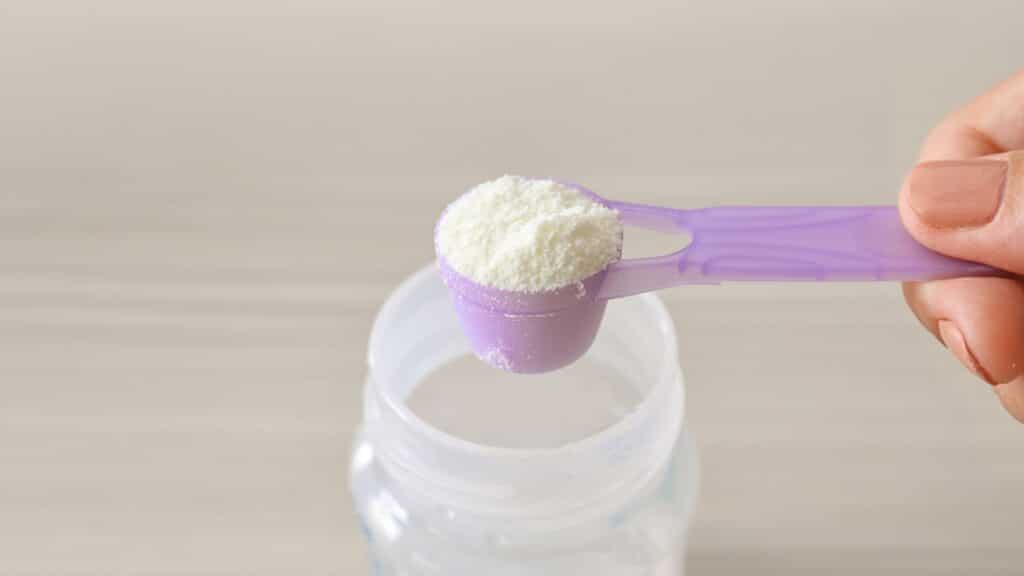Due to the recent formula shortage, many parents are struggling to find a suitable formula brand supply for their baby. If you’re one of the many parents and caregivers to find a baby formula, you’re not alone.
Many companies are experiencing supply chain issues across the country, primarily because of Abbott Nutrition’s facility closure in Sturgis, Michigan.
The formula shortage has become unprecedented, resulting in the White House’s plan to use a three-step plan to battle the infant formula shortage. But as the government is still resolving the issues, parents are now left with resolving the shortage by switching formula brands. But how do you successfully switch from one formula brand to another? Let’s take a closer look.

Reasons Why Parents Switch Baby Formula Brands
There are many reasons why parents choose to switch formulas. Some parents and caregivers might blame their baby’s formula for their baby’s sleepless nights and fussiness. Meanwhile, others consider the price, ease of preparation, and availability when switching formula products.
Whatever the reason may be, there are several factors that parents should consider when switching baby formulas. Here are a few signs that you need to watch out for.
All cow’s milk-based formula products and iron-fortified formulas are excellent sources of protein and lactose as carbohydrates. However, there are times when these protein sources can cause minor problems with your baby’s health.
Here are a few signs to tell if it’s time to switch baby formulas.
Common Signs to Help You Determine If You Need to Switch to a New Baby Formula
Spitting Up
While some parents are uneasy seeing their babies spit up, it is common for newborns. Although every baby is unique, it primarily results from an immature digestive system.
Remember that the sphincter between your baby’s esophagus and stomach is still developing. So, it’ll take time for their digestive system to digest the baby formula from their stomach. So, it’s no wonder baby formula milk can come back up.
Irregular Bowel Movements
Baby formula can also cause babies to become constipated. Although most formula-fed babies have regular bowel movements, there are times when some may go past two days to pass stools.
Because the baby’s abdominal muscles are still weak, it’ll sometimes be hard to pass stools even if they fuss or grunt.
Gassiness
There are also times when baby formulas can cause babies to become gassy. Gas is often unavoidable and usually occurs when your baby swallows too much air when crying or drinking. Gas bubbles can be pretty painful for babies. But as their digestive system and abdominal muscles develop, they’ll become better at handling gas.
Encouraging babies to consume infant formula can also cause your baby to either spit up or become gassy. So, to help prevent it, you need to figure out how to tell when they’re full or still hungry to prevent them from getting gassy afterward.
Excessively Gradual Weight Gain
Monitor your baby’s weight gain and diaper change to check overall well-being. In most cases, babies often gain weight between 10 to 14 days after birth.
Babies also start gaining 1 ounce daily between birth and three months of age [1]. Then, it’ll slow down to .67 ounces per day once they reach six months. If you notice that your baby isn’t gaining weight properly, then it’s best to discuss it with your child’s doctor.
Extra Fussiness After Feeding
Another way to tell if it’s time to consider switching formula products is by observing your babies to see if they’re extra fussy after feeding.

Allergy Symptoms
If your baby is showing signs of allergy symptoms, then it’s time to switch to a new formula. There are times when babies can be allergic to cow’s milk infant formula because of its protein content. So, if your baby is showing signs of allergy, it’s best to consider switching to something else.
An estimated 2% to 3% of infants show signs of milk allergy during their first few months. Although most babies outgrow it, there are others who tend to carry them on throughout their lives.
Besides skin rashes, babies with milk allergies often experience vomiting and loose stools. They also tend to become fussy and refuse bottles. Some even develop hives and anaphylactic shock, common for those with food allergies.
Primary Types of Protein in Formula
- Cow’s Milk Protein is the most commonly found in most formula brands.
- Soy Protein is another source for babies, especially those with particular health conditions such as casein or whey allergy.
- Hypoallergenic Protein contains broken-down protein to help address health issues for babies who can’t digest intact protein. These types of infant formula brands tend to be expensive and not taste good at the same time. It’s also referred to as an extensively hydrolyzed formula.
- Partially or fully hydrolyzed formulas are also broken down, which is highly advisable for babies with eczema or acid reflux symptoms. Some formula brand products also include 100% whey protein, while others use a casein-whey blend for additional whey content as part of their organic formula.
When you’re planning to switch baby formula, ensure that you still choose the same type of protein, no matter the brand. It’s also best to speak with a board-certified pediatrician when switching formulas.
A baby normally can throw a crying fit for countless reasons. But when your baby seems inconsolable when you feed them cow’s milk-based formula or any other type, there’s a chance that your baby might have formula intolerance.
Practical Tips to Help You Switch to a New Formula
Speak with a Pediatrician
To get more tips, you should speak to your pediatrician when switching infant formula. There are times when babies develop allergies or intolerances during the early onset of their development, and switching to a new formula may provide little benefit to address it.
That’s why it’s highly advisable to speak with your child’s pediatrician before changing their diet. Doing so can help reduce babies’ allergic reactions while providing them with a sufficient amount of nutrients at the same time.
Consider The Protein Type of the New Formula
As previously discussed, there are different types of baby formula, depending on what your baby needs.
Besides milk-based formulas and breast milk, other protein sources are available for babies. So, choosing which will best suit your baby’s needs is best to ensure optimum nutrition.
Choose the Best Transition Techniques
When transitioning from other breast milk or powdered formula into a new formula, there are two accepted methods accepted by experts:
- One-step transition: If your baby is switching from standard powdered formula to a new formula made to be easily digestible, there’s no need for transition time to start, as there should only be a few side effects. However, you still need to monitor your baby’s bowel movement or signs of formula intolerance.
- Slow transition: For babies transitioning from standard formula to specialized formula, such as hypoallergenic formula or soy formula, parents should gradually introduce it to monitor potential side effects.

Check for Formula Safety
All infant formulas are safe and meet FDA nutrient criteria (U.s. Food and Drug Administration). While every brand name may have differing ingredients, they must meet federal nutrition and safety standards set by the FDA.
When looking for the best type of formula at the store, it’s crucial to read the expiration date printed on the formula package before switching from your baby’s current formula. Meanwhile, if you’re ordering online, it’s best to check to date before opening it so that you can easily return it if it’s expired. Also, observe if there is any discoloring or offputting odor before mixing your milk-based formula.
Follow the Mixing Instructions
Depending on the type of formula, it’s essential to read and follow the mixing instruction printed on the packaging. Never assume that all infant formulas follow the same water ratio to the powder.
For example, one brand may recommend 3 ounces of water per 1 scoop of formula, while another brand may suggest 2 ounces of water per 1 scoop. Make sure to follow the ratio printed on the specific type of formula you purchase for your baby.
Moreover, use only clean and safe bottle-feeding equipment, such as bottles and nipples, before mixing your baby’s specialty formula.
Wait for the Results
It’s essential to determine what’s normal and what should be a red flag regarding your baby’s digestive system. So, before considering switching from your baby’s current formula to a new formula, it’s best o make the proper preparations and that you are basing it on your baby’s fullness and hunger cues.
It’s also crucial that switching from the current formula to the hypoallergenic formula takes time. It might take more than two weeks to get used to the changes. So, ensure that you give your baby some time to adjust.
Conclusion
It’s crucial to consult your baby’s pediatrician before you switch formula for babies. If your previous formula isn’t available, try another formula brand. You can also consider trying out a generic store brand identical to your formula and monitor your infant for side effects. In this current formula shortage, doing a formula switch is perfectly fine as long as your baby’s healthcare provider supervises it.
I hope this article helped you learn a few things about this topic. Let us know in the comments if you have any questions.



